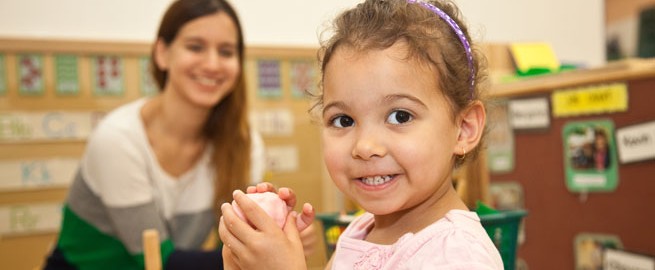Guidelines for Toddlers – What You Want to See!
What You Want to See |
What You Don’t Want to See |
| Children remain with a primary caregiver over time so they can form a strong relationship with him/her. The caregiver learns to respond to the toddler’s individual temperament, needs and cues, and builds strong communication with the child’s family. | One-to-one relationships between children and caregivers are not top priority. Toddlers are shifted from group to group or cared for by which ever caregiver is available at any given time. |
| Caregivers praise children for their accomplishments and help them to feel more confident and in control of themselves. | Toddlers are criticized for their clumsy attempts to master skills.
OR Caregivers are overly protective, making toddlers feel that they cannot do things for themselves.
|
| Caregivers, recognizing that toddlers are not yet able to communicate their needs through language, promptly respond to children’s cries or other sighs of distress. | Crying is ignored; caregivers do not respond consistently to children; only at their convenience. |
| Caregivers communicate their warmth through pats on the back and hugs, or holding toddlers in their laps. | The home or center has “no-touch policies” that ignore the importance of touch to children’s healthy developmental needs. |
| Caregivers set good examples for children by treating others with kindness and respect. | Adults are harsh to children when under stress. Their attempts to punish or control aggressive toddlers only cause more hostility. |
| Recognizing that frequent testing of limits and saying ‘No’ is part of a toddler’s healthy development, caregivers minimizing their restrictions unless children are in physical or emotional danger. Rather than merely refusing and restraining children, caregivers offer a few options and emphasize what the child is allowed to do. | Caregivers constantly say ‘No’ to children even when there is no threat to their well- being. Children are punished for asserting themselves.
OR Caregivers ignore children and allow aggressive behavior to escalate.
|
| The setting is ‘inclusive’, that is, physical space and activities allow all children to participate. For example, a child with a physical disability eats at the table with other children. | Caregivers do not include children with special needs in everyday activities such as eating or playing with other children. |
| Caregivers frequently read to toddlers, individually on the adult’s lap or in groups of two or three. Caregivers sing to toddlers, do finger-plays, and acts out simple stories as children actively participate. | Caregivers expect children to sit in large groups and watch activities, having little opportunity to participate. |
| Every day tasks such as eating, toileting, and dressing are opportunities for toddlers to learn new skills and better control their own behavior. Caregivers support toddlers’ attempts to take care of themselves and provide items that are easy for toddlers to use. | Children feel dependent and incompetent because caregivers do everyday tasks for them. Eating utensils, for instance, are not designed for children’s easy use. |
| Children have many opportunities for active, large-muscle play both indoors and outdoors. Play equipment is safe and challenging for toddlers. Their outdoor space is separate from that of older children. | Indoor space is cramped and unsafe for toddlers who are just learning on how to move their bodies and need to run more than walk. Caregivers spend time trying to control toddlers’ movements. |
| Adults follow health and safety procedures, including proper hand washing methods and universal precautions. Each area has clearly written procedures for waste disposal. | Health and safety procedures have not been clearly thought through and are not written or displayed. Consequently, adults forget hand washing or other essential precautions. |
| Caregivers directly supervise toddlers by sight and sound, even when they are sleeping. | Caregivers leave children unattended when they are playing or sleeping. |
| Caregivers see parents as the primary source of affection and care for children. Parents are always welcome to the Center. | Caregivers make parents feel in the way or isolated from their child’s experience. They may demonstrate competitive or patronizing attitudes towards parents. |
| Caregivers have training in child development or early education specific to the toddler age group. They are warm and responsive to children’s needs and patient in supporting children as they become more independent. | Caregivers have little training with toddlers. They expect too much or too little of toddlers and view working with this age group as a chore or merely as ‘babysitting’. |
| A maximum group size of 12, with 1 adult for no more than 6 toddlers allows for an intimate atmosphere and the high level of supervision that toddlers require. | Both group and the child-staff ratio are too large to allow for adequate supervision and individual attention to each child. The staffing schedule results in toddlers relating to several adults over the day |
| The staffing schedule allows for each toddler to develop a close relationship with a primary caregiver. Toddlers stay in the same group for many months to ensure close relationships. | Caregivers shift often from child to child or group to group.
OR Poor working conditions and/or compensation cause a high rate of turnover among staff. |



